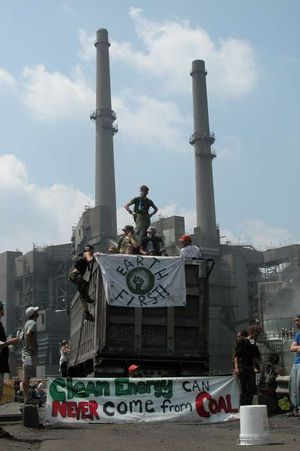Michael G. Morris
Michael G. Morris is the leader of the largest private sector consumer of coal in the United States.[1] Morris has been president, chief executive officer, and chairman of American Electric Power since 2004.[2]
Contents
Background
Prior to joining AEP he was chairman, president and chief executive officer of Northeast Utilities System, beginning in 1997. Prior to joining Northeast Utilities, Morris was president and chief executive officer of Consumers Energy, the principal subsidiary of CMS Energy, and president of CMS Marketing, Services and Trading. Previously, Morris served as president of Colorado Interstate Gas Co. (CIG) and as executive vice president of marketing, transportation and gas supply for ANR Pipeline Co., both of which are subsidiaries of El Paso Energy. Morris also founded and served as president of ANR Gathering Co., one of the first gas marketing companies in the United States.[2]
Morris has served on the U.S. Department of Energy’s Electricity Advisory Board, the National Governors Association’s Task Force on Electricity Infrastructure, and the Connecticut Governor’s Council on Economic Competitiveness & Technology. He is a trustee of the Bushnell Overseers and the Board of Regents of Eastern Michigan University. He is also a director of St. Francis Care Inc., Nuclear Electric Insurance Limited, American Gas Association, Spinnaker Exploration, Flint Ink Corp., Webster Financial Corp. and Cincinnati Bell. He is second vice chair for the Edison Electric Institute, and past chairman of the Board of the Connecticut Business & Industry Association.
Morris graduated from Eastern Michigan University in 1973, then worked in the environmental department of Commonwealth Associates, where he prepared environmental impact statements for electric utility transmission lines, natural gas and oil pipelines and power plants.
Morris received a law degree, cum laude, from the Detroit College of Law and is a member of the Michigan Bar Association. He is a past member of the Board of the Detroit College of Law, the Institute of Gas Technology, Eastern Michigan University Foundation, the Olivet College Leadership Advisory Council, and the Library of the Michigan Foundation.
Compensation
In May 2007, Forbes listed Morris as receiving $13.05 million in total compensation for the latest fiscal year, with a three-year total compensation of $22.03 million. He ranked 3rd on the list of CEOs in the Utilities industry, and 137th among all CEOs in the United States.[3]
Statement against new coal plants
In November, 20007, Morris told the Economist magazine: "No utility with any respect for its shareholders money would build a heavily polluting coal burning power plant in America these days; for fear that it would become a liability if the government moved to limit emissions of greenhouse gases." [4]
Citizen action and protest against AEP

July 10, 2006: Earth First!/Rising Tide blockade of Clinch River Power Plant
On July 10, 2006, 75 Earth First! and Rising Tide North America activists blockaded an access bridge leading to American Electric Power's coal-fired Clinch River Power Plant near Carbo, Virginia. Several people stretched a rope across the bridge and suspended themselves off the bridge's edge; others waved a coal truck onto the bridge, blockaded it, deflated its tires, and locked themselves to the truck. The protestors demanded that Clinch River and other outdated coal plants be shut down, and that mountaintop removal coal mining be ended. After several hours in which coal trucks were unable to get into the plant, police agreed to make no arrests if the activists would dismantle their blockades.[5][6]
Proposed coal plants
- Hempstead (sponsored by Southwestern Electric Power Co (SWEPCO), a subsidiary of American Electric Power)
Existing coal-fired power plants
AEP had 52 coal-fired generating stations in 2005, with 26,595 MW of capacity. Here is a list of AEP's coal power plants with capacity over 100 MW:[7][8][9]
| Plant Name | State | County | Year(s) Built | Capacity | 2007 CO2 Emissions | 2006 SO2 Emissions | Annual Deaths[10] |
|---|---|---|---|---|---|---|---|
| John E. Amos | WV | Putnam | 1971-73 | 2933 MW | 15,300,000 tons | 117,299 tons | 87 |
| Rockport | IN | Spencer | 1984, 1989 | 2600 MW | 16,600,000 tons | 83,543 tons | 140 |
| Gavin | OH | Gallia | 1974, 1975 | 2600 MW | 18,700,000 tons | 24,787 tons | 45 |
| Conesville | OH | Coshocton | 1962, 1973, 1976, 1978 | 1891 MW | 9,060,000 tons | 90,540 tons | 44 |
| Cardinal | OH | Jefferson | 1967, 1977 | 1880 MW | 10,100,000 tons | 86,880 tons | 55 |
| Welsh | TX | Titus | 1977, 1980, 1982 | 1674 MW | 11,900,000 tons | 37,154 tons | 37 |
| Mitchell | WV | Marshall | 1971 | 1633 MW | 8,478,000 tons | 53,152 tons | 51 |
| Muskingum River | OH | Washington | 1953, 1954, 1957, 1958, 1968 | 1529 MW | 7,299,000 tons | 122,984 tons | 28 |
| Mountaineer | WV | Mason | 1980 | 1300 MW | 7,727,000 tons | 31,052 tons | 38 |
| Philip Sporn | WV | Mason | 1950-52, 1960 | 1106 MW | 5,407,000 tons | 39,741 tons | 110 |
| Tanners Creek | IN | Dearborn | 1951, 1952, 1954, 1964 | 1100 MW | 5,963,000 tons | 35,494 tons | 120 |
| Big Sandy | KY | Lawrence | 1963, 1969 | 1097 MW | 5,807,000 tons | 46,476 tons | 55 |
| Northeastern | OK | Rogers | 1979, 1980 | 946 MW | 7,511,000 tons | 34,645 tons | 62 |
| Pirkey | TX | Harrison | 1985 | 721 MW | 6,037,000 tons | 32,391 tons | 20 |
| Oklaunion | TX | Wilbarger | 1986 | 720 MW | 5,016,000 tons | 3,794 tons | 7 |
| Clinch River | VA | Russell | 1958, 1961 | 713 MW | 3,680,000 tons | 27,134 tons | 69 |
| Kammer | WV | Marshall | 1958-59 | 713 MW | 3,244,000 tons | 119,369 tons | 70 |
| Flint Creek | AR | Benton | 1978 | 558 MW | 3,977,000 tons | 8,526 tons | 20 |
| Kanawha River | WV | Kanawha | 1953 | 439 MW | 1,820,000 tons | 13,543 tons | 40 |
| Glen Lyn | VA | Giles | 1944, 1957 | 338 MW | 1,356,000 tons | 13,632 tons | 31 |
| Picway | OH | Pickaway | 1955 | 106 MW | 366,000 tons | 15,071 tons | not available |
| Total | 26,597 MW | 155,348,000 tons | 1,037,000 tons | 1,129 |
In 2005, AEP's 21 major coal-fired power plants emitted 155.3 million tons of CO2 (2.6% of all U.S. CO2 emissions) and 1,037,000 tons of SO2 (6.9% of all U.S. SO2 emissions).
Death and disease attributable to fine particle pollution from AEP coal plants
In 2010, Abt Associates issued a study commissioned by the Clean Air Task Force, a nonprofit research and advocacy organization, quantifying the deaths and other health effects attributable to fine particle pollution from coal-fired power plants.[11] Fine particle pollution consists of a complex mixture of soot, heavy metals, sulfur dioxide, and nitrogen oxides. Among these particles, the most dangerous are those less than 2.5 microns in diameter, which are so tiny that they can evade the lung's natural defenses, enter the bloodstream, and be transported to vital organs. Impacts are especially severe among the elderly, children, and those with respiratory disease. The study found that over 13,000 deaths and tens of thousands of cases of chronic bronchitis, acute bronchitis, asthma, congestive heart failure, acute myocardial infarction, dysrhythmia, ischemic heart disease, chronic lung disease, and pneumonia each year are attributable to fine particle pollution from U.S. coal plant emissions. These deaths and illnesses are major examples of coal's external costs, i.e. uncompensated harms inflicted upon the public at large. Low-income and minority populations are disproportionately impacted as well, due to the tendency of companies to avoid locating power plants upwind of affluent communities. To monetize the health impact of fine particle pollution from each coal plant, Abt assigned a value of $7,300,000 to each 2010 mortality, based on a range of government and private studies. Valuations of illnesses ranged from $52 for an asthma episode to $440,000 for a case of chronic bronchitis.[12]
Table 1: Death and disease attributable to fine particle pollution from American Electric Power coal plants
| Type of Impact | Annual Incidence | Valuation |
|---|---|---|
| Deaths | 1,127 | $8.23 billion |
| Heart attacks | 1,758 | $192.0 million |
| Asthma attacks | 17,989 | $0.9 million |
| Hospital admissions | 209 | $19.37 million |
| Chronic bronchitis | 674 | $299.18 million |
| Asthma ER visits | 996 | $0.4 million |
Source: "Health Impacts - annual - of Existing Plants," Clean Air Task Force Excel worksheet, available under "Data Annex" at "Death and Disease from Power Plants," Clean Air Task Force. Note: This data includes the following plants owned by AEP and subsidiaries Appalachian Power, Cardinal Operating Company, Central Operating Company, Columbus Southern Power Company, Indiana Michigan Power, Kentucky Power Company, Ohio Power, Southwestern Electric , and Public Service Company of Oklahoma: Clinch River, Glen Lyn, Amos Plant, Kanawha, Mountaineer Plant (Appalachian Power Co); Cardinal, (Cardinal Operating Co.); Philip Sporn, (Central Operating Co); Conesville, (Columbus Southern Co); Tanners Creek, Rockport Plant, (Indiana Michigan Power Co); Big Sandy Plant (Kentucky Power Co.); Gavin Power Plant, Kammer Plant, Mitchell Plant, Muskingum, (Ohio Power Co); Northeastern Station, Riverside Power Plant, (Public Service Company of Oklahoma), Flint Creek, Pirkey and Welsh, (Southwestern Electric Power Co).
Resources
References
- ↑ Existing U.S. Coal Plants
- ↑ 2.0 2.1 "AEP board elects Michael G. president, CEO, and chairman elect," AEP press release, December 16, 2003
- ↑ CEO Compensation: #137 Michael G Morris, Forbes.com, May 3, 2007.
- ↑ "Coal Power," The Economist, November 17, 2007, p.71
- ↑ Earth First! Blockades Power Plant, Asheville Global Report, July 26, 2007.
- ↑ Resisting King Coal, Rising Tide website, July 11, 2006.
- ↑ "Existing Electric Generating Units in the United States, 2005", Energy Information Administration website, accessed April 2008.
- ↑ Environmental Integrity Project, Dirty Kilowatts: America’s Most Polluting Power Plants, July 2007.
- ↑ Dig Deeper, Carbon Monitoring for Action database, accessed Aug. 2008.
- ↑ Deaths attributable to fine particle pollution, as estimated by Abt Associates. See interactive map at "Find Your Risk from Power Plant Pollution," Clean Air Task Force interactive table, accessed February 2011. Also see "The Toll from Coal: An Updated Assessment of Death and Disease from America's Dirtiest Energy Source," Clean Air Task Force, September 2010, and "Technical Support Document for the Powerplant Impact Estimator Software Tool," Prepared for the Clean Air Task Force by Abt Associates, July 2010
- ↑ "The Toll from Coal: An Updated Assessment of Death and Disease from America's Dirtiest Energy Source," Clean Air Task Force, September 2010.
- ↑ "Technical Support Document for the Powerplant Impact Estimator Software Tool," Prepared for the Clean Air Task Force by Abt Associates, July 2010
Related SourceWatch articles
External resources
- "AEP Looks to reduce coal CO2 emissions," Seeking Alpha, March 19, 2007
